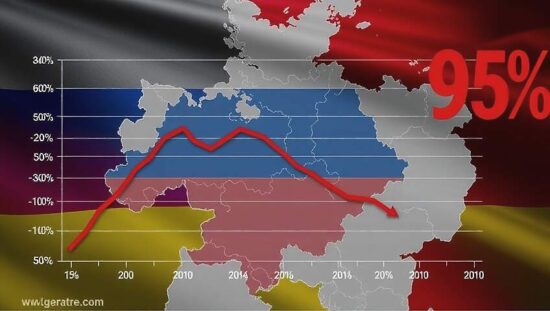A Dramatic Shift in the Past Year
Germany’s imports from Russia have plummeted by 94.6 percent compared to 2021, the year before the war in Ukraine began, according to the Federal Statistical Office (Destatis). In 2024, Germany imported goods worth 1.8 billion euros from Russia, a significant decline from the 33.1 billion euros in 2021. The 17 EU sanctions packages against Russia have had a significant impact on trade between the two nations.
Germany’s exports to Russia have also decreased, but to a lesser extent, with a decline of 71.6 percent over the same period. In 2024, Germany exported goods worth 7.6 billion euros to Russia, compared to 26.6 billion euros in 2021.
The European Union (EU) has implemented a range of sanctions since Russia’s invasion of Ukraine, aimed at restricting trade with Russia. The sanctions include import bans on certain goods, such as energy and export bans on industrial and military-related products, as well as restrictions on Russia’s access to capital and financial markets and the exclusion from the SWIFT banking system.
The measures are designed to prevent circumvention of existing sanctions through trade with third countries, but the effectiveness of this can only be gauged by examining external trade data.
Russia’s share of Germany’s total imports has decreased significantly, from 2.8 percent in 2021 to just 0.1 percent in 2024. In terms of exports, Russia’s share of Germany’s total exports has also declined, from 1.9 percent in 2021 to 0.5 percent in 2024.
Germany recorded its largest trade surplus with Russia since the fall of the Soviet Union in 1991, with a surplus of 5.8 billion euros in 2024. This is the fourth time a trade surplus has been recorded, following the years 2023, 2020 and 1993. In contrast, Germany recorded a trade deficit of 21.8 billion euros in 2022, a record high.
The most important import from Russia in 2024 was metals, worth around 0.8 billion euros and accounting for 42.3 percent of all imports from Russia. Chemical products and food and animal feed followed, with 24.7 percent and 15.2 percent of all imports, respectively.
In terms of exports to Russia, pharmaceutical and similar products accounted for around a third of the total, worth 2.3 billion euros, followed by chemical products and machinery, with 13.9 percent and 11.9 percent of the total, respectively.
The EU as a whole has also significantly reduced its trade with Russia. While the EU’s imports from Russia increased to a record high of 163.6 billion euros in 2022 due to the surge in energy prices, they have since declined by 78 percent to 36 billion euros in 2024. The share of Russian imports in the EU’s total imports has decreased from 7.7 percent to 1.5 percent over the same period.
The EU’s exports to Russia have also declined, with a fall of 64.6 percent over the three-year period. In 2024, the EU exported goods worth 31.6 billion euros to Russia, compared to 89.2 billion euros in 2021. The share of Russian exports in the EU’s total exports has decreased from 4.1 percent to 1.2 percent over the same period.
As a result, the EU’s imports from Russia now only exceed its exports to Russia by a small margin of 4.5 billion euros, the lowest trade deficit since the start of the data series in 2002. In contrast, the trade deficit reached a record high of 147.5 billion euros in 2022. The main reason for the continued trade surplus is that the EU still imports significant amounts of oil and gas from Russia, with a total value of 21.3 billion euros and a share of 59.1 percent of all EU imports from Russia. Hungary, the Slovak Republic and France were the largest EU importers of Russian oil and gas in 2024, with shares of 21.8 percent, 15.8 percent and 14.5 percent, respectively.





